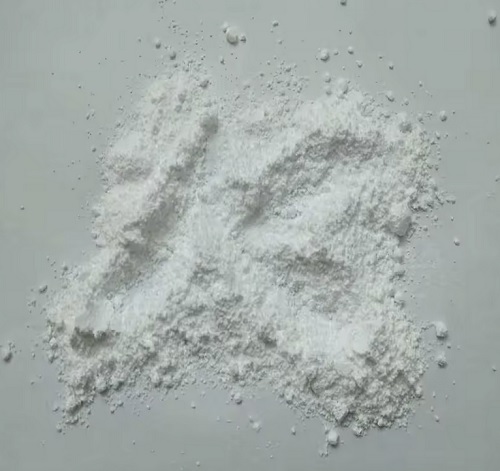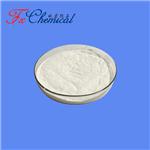Overview
Calcium stearate also known as calcium octadecanoic acid. Light white crystalline powder. Chemical formula (C17H35COO) 2Ca. The molecular weight is 607.00. Melting point 179~180 ℃, decomposed by heat. Insoluble in water, cold ethanol and diethyl ether, soluble in hot benzene, toluene, and turpentine, slightly soluble in hot ethanol and diethyl ether. It reacts with strong acid to be decomposed into stearic acid and corresponding calcium salt. Water absorption in the air. Intolerance lipolytic microorganisms. Pyrolysis to generate stearin ketones and hydrocarbons. Non-toxic. Industrial often mixed with the corresponding oleate.As stabilizers and lubricants of polyvinyl chloride; as halogen absorbent of polyethylene and polypropylene; as lubricants of polyolefin fibers and molded products; as lubricant and release agent of phenolic, amino and other thermosetting plastics; as intensifier of lubricating grease; as waterproofing agent of waterproof fabric; etc. Food grade Calcium stearate serves as an anti-caking agent. Dilute soap is made by the reaction of melt stearic acid and sodium hydroxide, reacting with calcium chloride, and Calcium stearate is obtained .

It can be used as heat stabilizer of polyvinyl chloride, it has excellent lubricity. Thermal stability performance is general, and is less than barium stearate, lead stearate, tin stearate and cadmium stearate. But it is cheap, low toxicity, good processability. Combined with Zinc soap and an epoxy compound, it shows a synergistic effect, improving the thermal stability, and it is commonly used for requirements nontoxic soft products, such as food packaging films, medical instruments, etc. It combines with the base lead salts and lead soaps used for hard products, increasing the gelation speed. Calcium stearate is used for polyethylene and polypropylene, and it can eliminate the adverse effects of residual catalyst on the resin color and stability. This product is also widely used as lubricant and release agent of thermosetting plastics, such as polyolefin, polyester reinforced plastics, phenolic resin, amino resin, etc.
The disadvantage of Calcium stearate is initial color. When heating at above 100 ℃ with longer time, Calcium stearate will make the white PVC become a reddish color. Particularly when titanium dioxide exists in formula, coloring is particularly serious. At this point, if 0.06~0.12% Na2CO3 or 0.09~0.19 NaHCO3 are added, it can overcome this shortcoming. But because these substances are too alkaline, they are not used in practice. In addition, when the amount of this product is large, there is segregation scaling phenomenon.
chemical properties
Calcium stearate is an odorless, white powder, Insoluble in water, slightly soluble in hot ethanol. It used in many manufacturing processes and preparations. Also known as calcium salt and octadecanoic acid, it is a carboxylate created by heating stearic acid and calcium oxide.
Calcium stearate has many potential uses, including as a flow agent, stabilizing agent and surface conditioner in the production of certain foods — notably, many candies. It is used as a mold-release agent for pharmaceutical tablets and capsules, as an anti-caking agent in cosmetics and as a thickener in lubricants and greases. It is also a stabilizer found in many plastics and is used to process concrete and paper.
Anti-caking agent
Anti-caking agent, also known as caking inhibitor, is used to prevent the particles and powdered food from aggregation and agglomeration, maintaining its loose or free flowing substances. Its particles is tiny, loose porous and strong adsorption. It easily absorbs the water and oil which lead to the formation of agglomerates, making food to maintain a powder or granules state.
There are five species of anti-caking agent which are permitted to be used in China: potassium ferrocyanide, sodium aluminosilicate, tricalcium phosphate, silica and microcrystalline cellulose.
Anti-caking agents are varied, in addition to five kinds which are permitted in China, aluminum, silica, calcium silicate, Calcium stearate, magnesium carbonate, magnesium stearate, magnesium, magnesium phosphate, magnesium silicate, kaolin, talc and ferrocyanide are permitted to be used in Foreign. In addition, they have anti-caking effect, and some also have other effects, for example, calcium silicate and kaolin also has the function of filter aids, and Calcium stearate and magnesium stearate have emulsifying effect. And in addition that ferrocyanide has limited ADI value, security of other varieties are very good, ADI values are no provisions. Based on requirement, proper developments are still needed.
Identification test
Taking 1 g sample, mixed with 25ml and 5ml hydrochloric acid water, heating, fatty acids are released, so that oily layer floats in the surface of the liquid. Water layer is used for calcium test (IT-10), and it should be positive.
Taking 25 g sample, mixed with 200 ml hot water, added sulfuric acid test solution (TS-241) 60ml, heating and vigorous stirring to precipitate fatty acid, there is clear liquid. Fatty washed with boiling water, until the sulfates is divisible, collected in a small beaker, warmed on a steam bath to completely separate the fatty acid from the aqueous layer, and kept clear. Cooled and discarded the aqueous layer, the fatty acid melted and filtered-dried beaker, dried at 105 ℃ for 20min. The freezing point of purified fatty acid should not be less than 54 ℃. Freezing point is determined by conventional methods.
Content analysis
About 1.2 g sample is accurately weighed, added 0.1 mol/L hydrochloric acid, boiled 10min, or until the fatty layer is clear, if necessary, adding water to maintain the original volume. Cooled and filtered, the filtrate and flask was washed thoroughly with water until last washing liquor is no longer acidic to litmus. Filtrate is treated with sodium hydroxide solution (TS-224.) and it is neutral to litmus. Under sufficiently stirred with a magnetic stirrer, about 30ml 0.05mol/L disodium EDTA is added via a 50ml burette, adding 15ml sodium hydroxide solution and 300 mg hydroxy naphthol blue indicator, and continuing the titration to a blue endpoint. Per milliliter 0.05mol/L disodium EDTA is equivalent 2.804 mg CaO.
Toxicity
ADI unrestrictive provision (FAO/WHO,2001).
GRAS(FDA,§184.1229, 2000).
Limitation of utilization
FAO/WHO (1984): coated with glucose powder, sucrose powder and stock cube, etc. 15g/kg.
GB 2760-1996: chewing gum base, GMP limit.
In USA, it is used for beet sugar, pressed candies, garlic salt, meat tenderizer, dry molasses, salad prefabricated powder, spice powder, yeast.
Uses
As non-toxic stabilizers and lubricants, mold release agents of polyvinyl chloride and water repellent of textiles.
As lubricant of coating paper and paint.
As internal lubricant and non-toxic stabilizers of polyvinyl chloride, and as mold release agents of the foundry industry.
Anti-caking agent; adhesive; emulsifier; lubricants; mold release agents; stabilizers; thickeners; flavoring agents.
As stabilizers and lubricants of polyvinyl chloride, and as non-toxic food packaging, medical devices and other soft film containers. As halogen absorbent of polyethylene and polypropylene, it can eliminate residual catalyst in resin. As lubricant of resin colors and molding products, but also as release agents of phenolic, amino thermosetting plastic and plastics and lubricant of polyester reinforced plastic, as thickening agent of grease, waterproofing agents of textile and flatting agent of paint. Food grade Calcium stearate can serve as an anti-caking agent to prevent powdered or crystalline food from aggregation and agglomeration, keeping free-flowing. But China's GB2760-86 allowing the use of anti-caking agent is currently only potassium ferrocyanide which is used for salt. According to the FAO/WHO regulations, Calcium stearate can be used for coating glucose powder, sucrose powder and stock cube, etc. , the maximum allowable amount is15 g/kg.
As a waterproofing agent, lubricant and plastic additives. It is widely used in food, medicine, cosmetics, plastics and rubber industries, mainly used for lubricants, emulsifiers, stabilizers, release agents, accelerators, cosmetic base materials. In the rigid plastics, it can increase the speed of the condensate. It can also be used for food packaging, medical devices and other non-toxic flexible film, but also has the effect of stabilizing agent and good long-term stability. As stabilizers and lubricants of polyethylene and polyvinyl chloride. As halogen absorbent of polyethylene and polypropylene, it can eliminate the adverse effects of residual resin on catalyst resin color and stability. It widely used to improve the heat resistance of plastic in foreign countries, improving weather resistance initial color and breathability. It will replace the toxic stabilizers with same performance.
Production methods
Firstly melted stearic acid reacts with sodium hydroxide solution to form a dilute soap, then reacted with calcium chloride, Calcium stearate crude is obtained, followed by washed, swirling water, drying, finished product is obtained. Kg/ton stearate, 920 sodium hydroxide (100% discount) 140 Calcium chloride (100% discount) 400.
After food grade sodium stearate interacts with calcium chloride solution, follow by filtered and refined.
Toxicity grading
Low toxicity
Acute toxicity
Oral-rat LD50:> 10000 mg/kg; Oral-mouse LD50:> 10000 mg/kg.
Chemical Properties
Calcium stearate occurs as a fine, white to yellowish-white, bulky powder having a slight, characteristic odor. It is unctuous and free from grittiness. It is found in some lubricants and surfactants.
Uses
Calcium Stearate is the calcium salt of stearic acid which functions
as an anticaking agent, binder, and emulsifier. it is used in garlic salt,
dry molasses, vanilla and vanilla-vanillin powder, salad dressing
mix, and meat tenderizer. it can be used for mold release in the
tableting of pressed candies.
Production Methods
Calcium stearate is prepared by the reaction of calcium chloride
with a mixture of the sodium salts of stearic and palmitic acids. The
calcium stearate formed is collected and washed with water to
remove any sodium chloride.
Preparation
Calcium stearate is produced by heating stearic acid, a fatty acid, and calcium oxide:
2C
17H
35COOH + CaO→(C
17H
35COO)
2Ca + H
2O
It is also the main component of soap scum, a white solid that forms when soap is mixed with hard water. Unlike soaps containing sodium and potassium, calcium stearate is insoluble in water and does not lather well . Commercially it is sold as a 50 % dispersion in water or as a spray dried powder. As a food additive it is known by the generic E number E470. .
Application
Calcium stearate is used as a flow agent in powders including some foods (such as Smarties), a surface conditioner in hard candies such as Sprees, a waterproofing agent for fabrics, a lubricant in pencils and crayons.
The concrete industry uses calcium stearate for efflorescence control of cementitious products used in the production of concrete masonry units i.e. paver and block, as well as waterproofing.
In paper production, calcium stearate is used as a lubricant to provide good gloss, preventing dusting and fold cracking in paper and paperboard making.
In plastics, it can act as an acid scavenger or neutralizer at concentrations up to 1000ppm, a lubricant and a release agent. It may be used in plastic colorant concentrates to improve pigment wetting. In rigid PVC, it can accelerate fusion, improve flow, and reduce die swell.
Applications in the personal care and pharmaceutical industry include tablet mold release, anti-tack agent, and gelling agent.
Calcium stearate is a component in some types of defoamers.
Definition
Calcium Stearate is an insoluble salt of octadecanoic acid. It is formed as "scum" when SOAP, containing the soluble salt sodium octadecanoate, is mixed with hard water containing calcium ions. Variable proportions of calcium stearate and calcium palmitate.
Flammability and Explosibility
Not classified
Pharmaceutical Applications
Calcium stearate is primarily used in pharmaceutical formulations
as a lubricant in tablet and capsule manufacture at concentrations
up to 1.0% w/w. Although it has good antiadherent and lubricant
properties, calcium stearate has poor glidant properties.
Calcium stearate is also employed as an emulsifier, stabilizing
agent, and suspending agent, and is also used in cosmetics and food
products.
Safety Profile
A nuisance dust. When
heated to decomposition it emits acrid
smoke and irritating fumes.
Safety
Calcium stearate is used in oral pharmaceutical formulations and is
generally regarded as a relatively nontoxic and nonirritant material.
storage
Calcium stearate is stable and should be stored in a well-closed
container in a cool, dry place.
Regulatory Status
GRAS listed. Included in the FDA Inactive Ingredients Database
(oral capsules and tablets). Included in nonparenteral medicines
licensed in the UK. Included in the Canadian List of Acceptable
Non-medicinal Ingredients.






